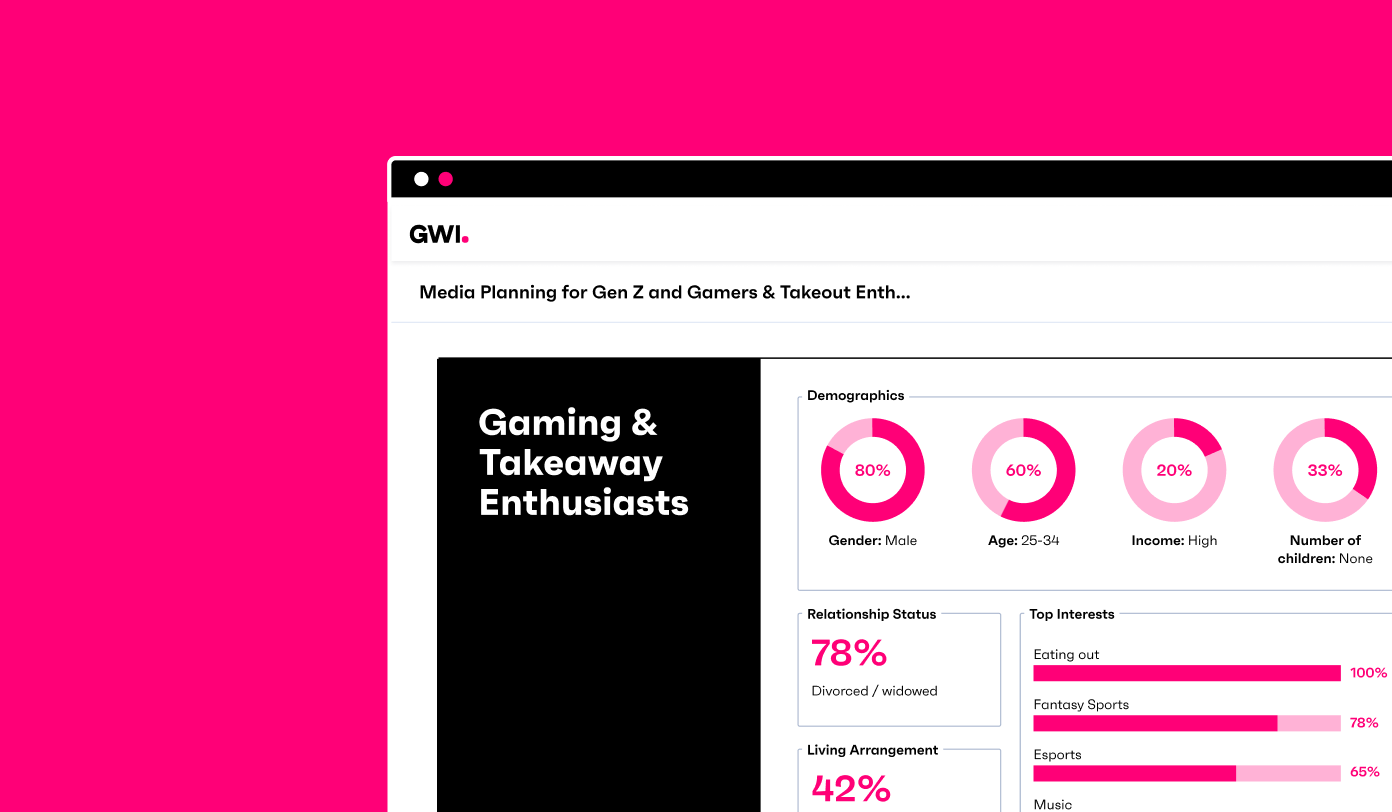In the fast-paced world of strategic planning, understanding consumer trends and behavior is essential. Market segmentation analysis is a powerful way to categorize consumers into distinct groups, helping you better understand their specific needs and craft more tailored marketing strategies.
In this blog, we’ll answer:
- What is market segmentation?
- What are the benefits?
- What types of market segmentation are there?
- What does the process look like?
- How does GWI help with market segmentation analysis?
With deeper insights into specific customer segments, it’s much easier to make data-driven decisions that give you a competitive edge. Let’s jump right into it.
What is market segmentation?
Market segmentation is the process of breaking down a broad consumer market into smaller, more specific groups or “segments” based on shared characteristics.
These groups, or segments, are often defined by:
- Demographics – such as age, gender, income, education level
- Geographic factors – both globally and at a regional level
- Psychographics – like lifestyle habits, personality traits, and values
- Behavioral traits – like buying habits, and social media preferences
By pinpointing these unique traits within consumer segments, businesses can more effectively allocate resources and develop marketing strategies that resonate with their target audiences.
This focused approach helps to boost both marketing efficiency and customer engagement, ensuring messaging, brand positioning, and overarching strategy are highly relevant to each segment’s specific needs and preferences.
What are the benefits of market segmentation?
Market segmentation helps focus your strategic planning to make sure you’re hitting the mark with your target consumers. This analysis gives businesses a clear picture of which segments hold the most value, and how best to engage with them. Key benefits include:
Better understand your audience
By segmenting consumers into distinct groups, you go beyond broad demographics and get a closer look at what’s driving their behavior. Not just what they’re doing, but why. This granular insight helps brands better align with what each consumer segment wants, which is key to crafting more effective advertising campaigns, building better products and services, and driving more ROI. It’s about understanding consumers’ core motivations, attitudes, and needs.
Do more with less, faster
Realistically, there’s no one-size-fits-all marketing strategy – and that’s where segmentation comes into its own. By focusing campaigns around specific, well-defined groups with specific wants and needs, you can tailor your messaging to speak directly to them. The result? A more efficient campaign with less wasted spend, higher engagement, and better returns. What’s not to like?
Identify new opportunities
Lucrative opportunities often lurk beneath the surface of your audience data – you just need to dig a little deeper to unearth them. Market segmentation helps you identify niche groups within your target audience that would otherwise be overlooked. This often reveals new areas to innovate, partner or sponsorship opportunities, or even chances to enter new markets. It’s about spotting what others miss and getting ahead of your competitors.
Build stronger customer relationships
Focusing on specific segments helps you connect with your target audience on a deeper, more personal level. By showing consumers that you really do get them, they’ll feel understood and valued, and will naturally advocate for your brand. You’re effectively turning one-time, transactional relationships into nurtured ones that boost brand loyalty and advocacy.
Gain a competitive advantage
Using insights from market segmentation will help you shape more bespoke targeting strategies with messaging that directly speaks to each consumer group. While others are busy with broad strokes, you’re painting with precision. This sharp focus also helps to position your brand as a leader in the market, with a strong presence and clear understanding of how you differentiate from the competition. Standing out for the right reasons gives you an unbeatable edge.
What types of market segmentation are there?
Market segmentation can be approached in various ways to craft more precise, impactful strategies that align with the unique attributes of each segment. The type of market segmentation you do will depend on the attributes you want to explore. Here are four easy ways to tackle it.
Demographic segmentation
Demographic segmentation is about pinning down the key characteristics that define who your customers are. It’s one of the most straightforward ways to segment your audience, and is highly effective in tailoring your approach to different groups. For example, you could look into:
- Age – preferences vary widely across generations, so it’s likely a campaign aimed at Gen Z will hit differently to one targeting baby boomers
- Gender – understanding how people’s needs differ helps you create more inclusive messaging, campaigns, and products
- Income – buying power has a big impact on consumer preferences; high income segments may seek premium options where others prioritize value
- Education level – this affects people’s interests, media consumption habits, and responsiveness to certain types of messaging
Geographic segmentation
Where people live often shapes their needs and wants, making geographic segmentation a powerful way to understand location-specific differences and cater to them. You might think about:
- Region – comparing distinct cultural preferences or needs, such as varying tastes in food or fashion
- City size – urban dwellers and rural residents often have vastly different lifestyles, influencing product demand and marketing channel preferences
- Climate – conditions help you determine what products are needed in specific areas, from snow gear in colder climates to lightweight, breathable fabrics in warmer regions
Psychographic segmentation
Going beyond what people do, psychographic segmentation dives into why they do it – exploring the attitudes that influence consumer behavior. These can include:
- Lifestyle habits – consumers’ activities, interests, and opinions have a big impact on their personal preferences
- Values – aligning with how people feel about things like sustainability or community helps brands create a deeper connection
- Personality traits – understanding different personality types is key to crafting bespoke messaging that resonates on an emotional level
Behavioral segmentation
Behavioral segmentation is all about understanding how consumers interact with your brand on their purchase journeys. Here are a few things you can look into to help optimize your marketing efforts:
- Purchase behavior – are your consumers occasional buyers or frequent shoppers? This helps you adjust your marketing strategy to better target specific groups
- Brand loyalty – customer retention is more important than ever, so use these insights to identify your best brand advocates
- Personalization – whether it’s introductory offers for new customers, or loyalty rewards for returning ones, give people more personalized experiences that reflect where they are in their buying journey
What’s the process of market segmentation analysis?
When it comes to market segmentation analysis, there are four key steps to follow if you want to develop a deeper understanding of your audience. Let’s break it down.
Step 1: Identify potential market segment
Gather and analyze audience data using a consumer research platform like GWI to uncover distinct groups within your target audience.
Here’s an example: A consumer electronics brand might want to understand budget-conscious millennials who favor value for money over having the latest gadget. You could find insights on device ownership, purchase influencers, and media habits, and compare these with other generations to piece together a clear picture of who your target segments are.
Step 2: Evaluate your segments
Assess each segment’s size, growth potential, purchase power, and how easy they are to reach and engage. Your focus segments should align with your wider strategic goals.
Here’s an example: A travel company looking to increase bookings might evaluate a segment of people interested in luxury travel experiences, versus those more interested in low-budget adventures. By comparing the two groups, they can quickly analyze which segment shows higher growth potential, and the digital channels they use regularly. Using these insights, they could create inspirational blog content for a social media campaign targeting the most viable segment, effectively boosting conversions and bookings.
Step 3: Develop positioning strategies
Craft positioning strategies that resonate deeply with your chosen target segments, paying special attention to their values and preferences.
Here’s an example: A telecomms company targeting tech-savvy Gen Zers might focus on a positioning strategy emphasizing cutting-edge technology and early access to new features, delivered via attention-grabbing short-form videos on TikTok and YouTube – just the kind of thing this audience loves.
Step 4: Optimize your strategy
Finally, you should continuously monitor performance and be prepared to adapt your strategy to shifting market dynamics and consumer trends.
Here’s an example: An online fashion retailer targeting eco-conscious consumers might use GWI to track how this segment reacts to its latest sustainability campaign. If engagement rates are lower than expected, they might consider optimizing the messaging, and making fair-trade product certifications clear to boost consumer confidence.
How does GWI help with market segmentation analysis?
Imagine knowing not only who your audience is – but what they value, how they spend their time online, and what drives their decision-making. Our intuitive consumer research platform gives you all the answers, making market segmentation analysis easy. Just follow the steps above.
For example, an online TV streaming service could dig into our data on media consumption habits to understand which consumers are binging content, the types of shows they’re interested in, and what kind of subscription they have – free with ads, or premium? And if they’re on a free plan, what would convince them to upgrade? This data-driven approach helps to identify key trends and shifting preferences within their target audience.
With GWI, you can go beyond basic demographics to group audience segments by attitudes, interests, digital behaviors, and much more. And with robust, global consumer data spanning 50+ markets, businesses get a complete understanding of their target audience in minutes. This helps you predict what consumers will do next and target specific segments with precision.
However you do it, market segmentation analysis is essential for making faster, data-backed decisions that improve marketing efforts, drive innovation, and foster business growth. It’s perfect for strategic planners looking to stay two steps ahead in a competitive business landscape.
Fancy a look around?
Book your demo






.webp?width=495&height=317&name=pink_thumb_graphs%20(1).webp)
.webp?width=495&height=317&name=pink_thumb_letter%20(2).webp)